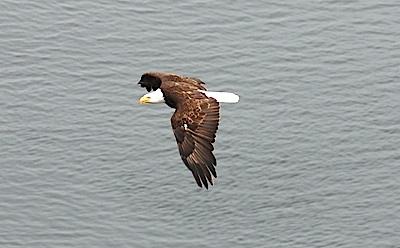I lowered my binoculars and muttered, “Oh, it’s just another eagle.” With that statement I recognized a few years ago that I officially had started taking Bald Eagles for granted.
On trips across the country in recent years, eagles have been a common sight, to the point that I was disappointed a distant soaring raptor wasn’t a hawk or a falcon – or anything that wasn’t an eagle. While I deserve to be chastised for ever failing to appreciate such a magnificent bird, the fact I can is part of one of the few good stories about species conservation.
Bald Eagles (Haliateeus leucocephalus), the national bird and symbol of the United States, now exist in 49 states and nest in at least 45 of those states. As an avid traveler of the national parks, I sometimes wonder how many NPS units have had reports of eagles. While the National Parks Conservation Association lists ten parks where eagles are found, including iconic sites like Acadia National Park and Glacier Bay National Park, that number is extremely conservative.
After a quick count, I believe I’ve spotted Bald Eagles in at least five units that aren’t mentioned on the NPCA’s list. Given their vast range and recent adaptations to urban environments, I don’t think there’s a unit in the contiguous 48 states and Alaska where an eagle would be that rare of a sighting.
In some spots they’re downright common. In Voyageurs National Park alone, 75 Bald Eagle nests were spotted last spring. Thirty-five years ago, no one was sure how long Bald Eagles as a species would exist. It was starting to look like we should have sided with Benjamin Franklin when he wanted to make the Wild Turkey our avian representative.
The cause of the eagles’ decline was no mystery, thanks to a recent awakening of ecological awareness among Americans. The hands on the alarm bell belonged to a quiet young woman from Pennsylvania named Rachel Carson. Ms. Carson was a marine biologist, starting out with a job with the U.S. government, but securing her future with the best-selling natural history tomes The Sea Around Us and The Edge of the Sea.
Somewhere during the waning days of World War II she became aware of a lurking menace known as dichlorodiphenyltrichloroethane, which normal people called DDT. Her attentions turned to the perils of synthetic pesticides, but knowing the public was deaf to conservation issues, she published nothing on the matter during the post-war boom. Finally, in 1962 she sounded the bell.

Bald Eagles, thanks in large part to Rachel Carson, are no rare birds these days. U.S. Fish and Wildlife Service photo.
Silent Spring sent shock waves through the American industrial complex and helped spawn the conservation movement that would christen Earth Day eight years later. Ms. Carson envisioned a spring morning of silence, absent of singing birds as their eggs had been rendered worthless by the lingering effects of pesticides.
Egg shells are thinned and female reproductive tracts damaged by DDT and the chemical compounds it degrades into once released into the environment. Osprey, Brown Pelicans, and Peregrine Falcons were severely impacted as well as the eagles.
The chemical industry reacted as would be expected. Apoplectic outrage would be an accurate description. Her thesis was flawed, they said. Her training was not relevant.
Unspoken by most, but always present, was the indictment of her worst offense: she was a woman trying to “do science.”
To Ms. Carson’s greatest credit, she persevered. She spoke whenever and wherever she could. She made sense. The public, the folks without a hint of training in ecology, believed her. And what a blessing that was, given that she was absolutely correct about what was happening to the birds.
Ms. Carson succumbed to breast cancer in 1964. DDT use was banned in the United States in 1972 (1985 in Canada). The Bald Eagle was made an official endangered species in 1973. Today Rachel Carson’s legacy of conservation lives on, DDT is sadly still widely used on other continents, and the Bald Eagle has gone from a mere 400 nesting pairs in the 1970s to hundreds of thousands of birds across the continent.
Two out of three ain’t bad, but there’s clearly more work to be done. And that’s the story I think of whenever I see an eagle, pelican, osprey, or falcon. I promise to not so quickly take these birds for granted. If you listen closely, you can hear a soaring eagle speak to the wind. Not the call the birdwatchers learn, but a grateful whisper to their existence. Thank you, Rachel, they say.
So, where have you seen Bald Eagles across our National Park System? My most memorable sighting was in Sleeping Bear Dunes National Lakeshore. I wasn’t even a birder at the time, although this incident may have spawned the hobby for me. While hiking the wilderness of North Manitou Island, an adult Bald Eagle flushed out of a low tree and nearly took my hat off as it flew inches above my head.
You tend to gain a quick appreciation for how BIG they are when you feel the wind from those wings on the back of your neck!




Comments
As I suspected the terms "psuedo-scientist" and "enironmentalist hack" don't appear in the quote. Sounds to me like his comment was quite rational and accurate.